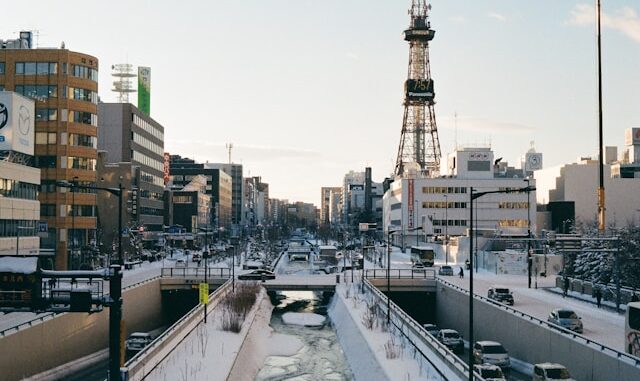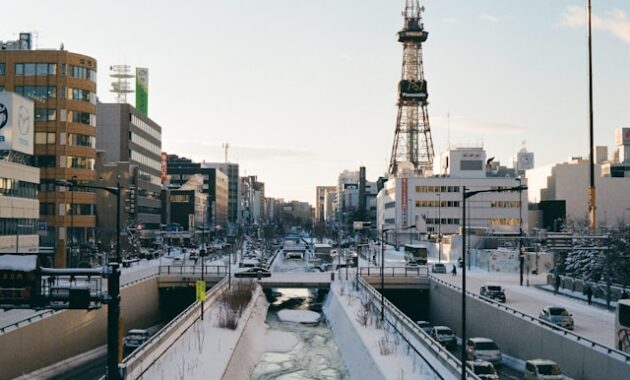
Sapporo, the capital city of Hokkaido, is a place where modern convenience meets natural beauty. Known for its snow festivals, ski resorts, and unique local cuisine, Sapporo is a prime destination not only for tourists but also for those considering a long-term stay or relocation. In this in-depth guide, we explore every facet of living in Sapporo—from the cost of living and lifestyle, to cultural experiences and quality of life.
Cost of Living in Sapporo: Affordable Urban Comfort

Living in Sapporo is significantly more affordable than Tokyo or Osaka, making it a preferred choice for expatriates, digital nomads, and retirees.
Housing Costs
Rental prices in Sapporo are refreshingly reasonable. A one-bedroom apartment in the city center typically costs between ¥50,000–¥70,000 (USD $350–$500) per month, while the same apartment outside the center can go for as low as ¥30,000 (USD $200). Utility costs—including electricity, water, and heating—average around ¥12,000–¥20,000 (USD $85–$140) per month.
Groceries and Daily Necessities
Sapporo offers a wide range of supermarkets and local markets. A typical grocery bill for a single person may fall between ¥25,000–¥35,000 (USD $180–$250) monthly. The availability of fresh seafood, vegetables, and locally sourced dairy is a major perk. Popular chains like Aeon, Seicomart, and Coop offer competitive pricing.
Transportation Expenses
The city’s public transportation system is efficient and affordable. A monthly subway pass costs around ¥10,000 (USD $70). Bicycles are also widely used, especially during the warmer months. Taxi fares begin at around ¥600 (USD $4.20).
Healthcare Costs
Japan’s national health insurance covers most medical needs. Monthly premiums in Sapporo range between ¥2,000 and ¥20,000 (USD $15–$150), depending on income. Clinics and hospitals are modern and accessible, with English-speaking staff available in some locations.
Cultural Richness and Everyday Life
Living in Sapporo means embracing a vibrant, unique culture shaped by both Japanese tradition and the distinct character of Hokkaido.
The Snow Culture and Seasonal Festivities
Sapporo is synonymous with snow, and the city transforms into a winter wonderland every year. The Sapporo Snow Festival, held every February, attracts over 2 million visitors with its magnificent ice sculptures and festive atmosphere. Winter sports, including skiing and snowboarding at Niseko or Teine, are only a short drive away.
Cuisine Unique to Hokkaido
The food culture in Sapporo is heavily influenced by the region’s agricultural and marine abundance. Iconic local dishes include:
- Soup Curry – A spicy, hearty stew served with rice and vegetables.
- Genghis Khan – A grilled lamb dish often enjoyed with beer.
- Miso Ramen – Originating from Sapporo, this savory noodle soup is world-renowned.
- Fresh Seafood – Crab, scallops, and salmon roe are staples at Nijo Market.
Dining out is affordable, with casual restaurants offering meals for ¥800–¥1,200 (USD $5–$9).
Friendly Locals and Community Life
Sapporo residents are known for their hospitality. The community spirit here is strong, and there are many events throughout the year that foster social interaction. From neighborhood matsuri (festivals) to local workshops and language exchange meetups, newcomers find it relatively easy to integrate.
Comfort and Quality of Life in Sapporo
Sapporo ranks high on comfort due to its clean air, relaxed pace of life, and efficient infrastructure.
Clean and Spacious Urban Design
The city is laid out in a grid pattern, making navigation intuitive. Streets are wide, public parks are numerous, and traffic is minimal compared to Tokyo or Osaka. Green spaces like Odori Park and Moerenuma Park offer daily escapes into nature.
Weather and Natural Beauty
While winters are cold and snowy, the city is well-equipped to handle the weather. Buildings are well-insulated, and underground walkways connect key parts of the city center. Summers are mild and pleasant, averaging around 26°C (79°F), with no humidity—a rarity in Japan.
Education and International Schools
For families, Sapporo offers high-quality education. Public schools are well-funded, and there are also international schools such as Hokkaido International School, which offers instruction in English and follows a Western curriculum.
Working in Sapporo: Opportunities and Lifestyle Balance
Although not as saturated with opportunities as Tokyo, Sapporo offers a balanced working life and growing prospects in tech, tourism, and education sectors.
Job Market Overview
Popular sectors include:
- English teaching – Numerous eikaiwa (language schools) and public school programs.
- Tourism and hospitality – Hotels, ski resorts, and travel agencies frequently hire multilingual staff.
- Remote work – A rising number of digital nomads find Sapporo ideal for its affordable living and fast internet.
Work-Life Balance
Hokkaido’s culture places greater emphasis on leisure and outdoor activity, leading to better work-life balance. The local pace is relaxed, and many employers in the area respect personal time.
Safety and Modern Conveniences
Sapporo consistently ranks as one of the safest cities in Japan. Crime rates are extremely low, and both locals and expatriates feel secure walking the streets at night.
Modern Amenities
The city boasts an impressive infrastructure:
- High-speed internet widely available.
- Smartphone apps for transportation and municipal services.
- International stores and services for groceries, banking, and shopping.
Convenience stores operate 24/7 and offer far more than snacks—they serve as hubs for bill payment, ATM use, and package delivery.
Challenges to Consider When Moving to Sapporo
While the city has much to offer, it is important to acknowledge certain hurdles.
Language Barrier
Outside of tourist areas, English proficiency can be limited. Daily life is manageable, but learning basic Japanese enhances the experience significantly.
Cold Winters
Sapporo’s winters are long and snowy, which may pose challenges for those unaccustomed to extreme cold. However, the city’s infrastructure is optimized for snow, including heated roads and efficient public transport.
Limited International Flights
Although New Chitose Airport is well-connected domestically, international flights are fewer than major hubs like Narita or Kansai. That said, connections through Tokyo are swift and efficient.
Conclusion: Why Sapporo is a Hidden Gem for Long-Term Living
For those seeking a high quality of life with a lower cost of living, Sapporo offers unmatched advantages. From its world-famous winters and exceptional cuisine to its affordable housing and tranquil lifestyle, this northern Japanese city is a compelling choice for anyone looking to live abroad or experience Japan beyond the beaten path.
Whether you’re a digital nomad, a family, or a retiree, Sapporo promises not only comfort but also a deeply enriching cultural experience that is hard to find elsewhere in Japan.